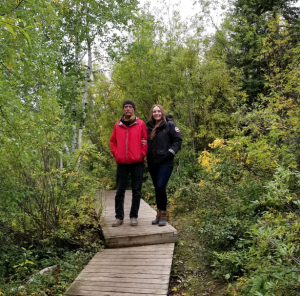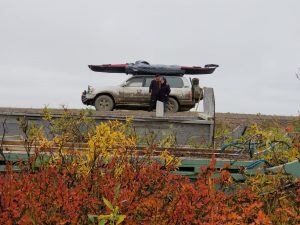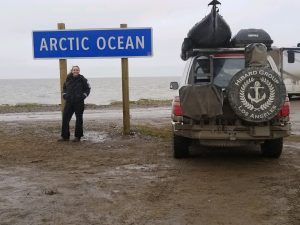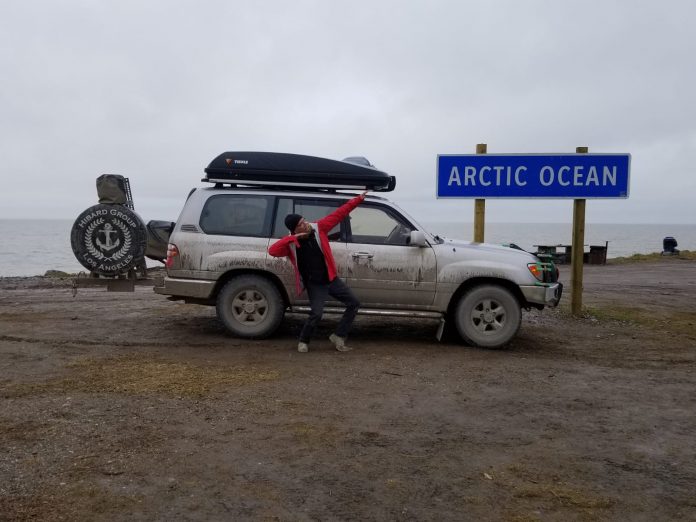By David N. Young
What kind of man comes home and tells his wife of 42 years to pack the SUV as he puts the kayak on top, throws in the ice chests and prepares to embark on a 7,000-mile road trip to the Arctic Ocean?
If you know George Hibard, Jr., of Los Alamitos, you may not at all be surprised to learn that’s exactly something he would do.
A conversation with Hibard quickly highlights a unique character akin to a modern Renaissance man, seemingly inclusive of equal measures of philosopher, inventor, comedian, adventurer, historian, and yes, a businessman.
Hibard is the second-generation operator of the family business, Spiral Paper Tube & Core (Pico Rivera), built by his dad George, Sr. His dad was a talented and ambitious machinist who served in World War II who went to the USC School of Business at night following his return from the war.

“My dad designed and built much of the early equipment” for the business, said Hibard, which uses complex technology to create paper tubes and cores, used in everything from school supplies to toilet paper.
Once he took the reins of the business in the 1990’s, Hibard added his own inventions to the product line, including paper edges that can today be seen protecting the edges of almost every pallet wrapped in plastic to be shipped.
Hibard is an unassuming and energetic man, eager to discuss interesting historical and cultural topics as much or more than business. With his family, he has traveled the world, from pole to pole, land and sea, from the steppes of Mongolia to the icebergs of Antarctica.
He and his wife Sarah have three daughters (Summer, Emily and Darci), which Hibard jokingly calls “Bonanza in drag.” Now, Hibard is beaming about a new granddaughter as well. Although he has cajoled and traveled with all of them at one time or another, middle daughter Emily slowly emerged as the most adventurous type.
They moved to Los Alamitos from Downey, said Hibard, to raise the family. “I love Los Alamitos,” he said. “Absolutely love it.”

Emily recalls once when she and good old dad once crossed the Andes Mountains and eventually kayaked in Antarctica, dad insisted on paddling around a two-story iceberg, even though she heard the guide expressly say it would be dangerous. “I heard it differently,” he shoots back with a bit of wry smile.
Almost finished circling the iceberg in their kayak, Hibard said they were startled with the sound of a massive boom, as the iceberg cracked and began disintegrating around them. “Stroke,” Hibard shouted to Emily, “stroke,” meaning for his daughter to “stroke” the paddle quickly so they could escape the danger of falling ice.
Though very deliberate, Hibard is obviously a driven man who is equally comfortable in his business as he is living on the edge of life, where he finds adventure and fulfillment. Life, he knows, is forever fleeting and he wants to make the most of it.
“I love to explore people and cultures,” says Hibard, never meeting anyone in the world with which he did not enjoy a meaningful conversation.
Following the Andes adventure, however, something on YouTube caught his interest.
For several years, Hibard said he has watched, and listened on YouTube to Merven Gruben, the mayor of Tuktoyaktuk, coax the national government to build a road from Inuvik. Tuktoyaktuk is a tiny hamlet on the edge of the Arctic Ocean in Canada’s Yukon Territories and a new highway would travel by road all the way to the Arctic Ocean.
In addition to his love for adventure, Hibard says he has always been fascinated with the Eskimo culture, how they learned to adapt, survive and thrive living in an icy culture, so he watched intently.
Three years passed and the Canadian government appropriated $300 million to connect the country by road to the Arctic. Once the road was finally opened, this was a challenge too tempting for George Hibard ‘s sense of adventure to resist. Imagining himself thundering down the road over permafrost and ice, he said to himself, “let’s do this.”
His idea came about the same time daughter Emily had announced the “Honor Project,” a documentary film honoring a number of local fathers for Father’s Day and certainly wanted to do something special for her own father. According to Emily, she thought there would be no better way to immortalize her adventurous father, and so the family’s road trip was on.

Ironically, Emily is not only the most adventurous, she is the only daughter not totally involved in the family business. Emily has founded the Hibard Group, producing a variety of film and media projects.
So, while she began shooting interviews with other dads to be featured in the “Honor Project,” dad and mom prepared to hit the road.
In another twist of fate, Hibard’s close friend, longtime traveling buddy and Bellflower businessman Christopher Wren, had just finished having an off-road sport utility jeep customized for rugged duty. Tragically, months before Wren’s retirement and completion of the SUV’s customization, Hibard said Wren was diagnosed with leukemia, then suffered a stroke, rendering him incapable of driving at all.
Wren moved to Mexico with his wife and threw the keys to the specially built SUV to Hibard, telling him to “wear this thing out.”
“It was the perfect vehicle for the Arctic,” said Hibard so they began packing.
While Emily stayed back to complete the local filming for the Honor Project, a determined dad and mom hit the road in August of 2018, determined to drive 3,500 miles from Los Al (and back) to the edge of the Beaufort Sea in the Arctic Ocean near Tuktoyaktuk.
In addition to survival gear, food, etc., Hibard packed enough gas cans to propel him 180 miles if, while in the Yukon Territories, they would not be able to get gas from one of the few stations along the way. “Yukon is extremely remote,” he says.
To put it in perspective, Hibard says the Yukon has the same area of territory as the Republic of France, yet it is populated by a mere 40,000 people. “Remote, very, very remote.”

Long before dealing with ice in the Yukon, however, they had to endure an endless stream of putrid smoke. Tons and tons of it. In the late summer of 2018, California endured hundreds of wildfires, the worst of which was located in the Mendocina National Forest, which sits right along the interstate route towards the Canadian border. “It was apocalyptic,” joked Hibard, “miles and miles and miles of smoke.”
For almost a month, Hibard and his wife Sarah took their time driving though the USA before reaching British Columbia, stopping often to relax and rest from the toxic smoke.
Once in British Columbia, there was no escape from the smoke as fire reporting statistics indicate that British Columbia suffered 600 wildfires last summer. Just to reach the Yukon, George and Sarah had to drive through near sickening smoke for almost 2,000 miles before reaching the Yukon territory.
Finally, however, they joyfully arrived in Whitehorse, the Yukon’s capital city, where Emily flew in from Los Angeles to join them. They repacked the SUV, including Emily’s camera gear, and hunkered down for the final stretch, driving through the Arctic Circle with a goal of kayaking in the Beaufort Sea.
After arriving in Inuvik, where the more famous Dempster Highway meets the new highway to Tuktoyaktuk, the shivering cold began to bite.
Conditions worsened but father, mother and daughter kept driving towards the Arctic Ocean.
The cold was more than offset by the incredible vistas of the Canadian Yukon, said Emily, as the muddy SUV rolled closer and closer to the Arctic Ocean.
The Hibards were prepared to sleep in the SUV, but fortunately, they were always able to get one of the few rooms at the sparsely located inns along the newly opened Arctic highway.
According to Emily, her dad spoke to “everyone” because almost everyone traveled to this part of the world “was here to do something really cool.”
Almost 3,500 miles from Los Alamitos, the Hibards, driving Wren’s SUV, pulled into the Tuktoyaktuk, and wouldn’t you know it, Hibard ran into Mayor Gruben himself. No joke. “Of course, I spoke with him,” says Hibard.

Emily was busy shooting film for the documentary as they finally arrived at the water’s edge in Tuk. It was below freezing, but she put the camera down to help her dad assemble the kayak.
“Mom was SO nervous,” said Emily, as “mom was having nightmares that they would not return from this kayak adventure in the Arctic.” Nevertheless, they persisted and began their effort to kayak in the Arctic. George Hibard is not a man to be denied.
For three hours, Hibard faced bitter cold, whipping winds and frozen fingers as he struggled to assemble the kayak, which had been folded to fit on top of the SUV.
He and Emily had agreed to wear dry suits, which are sealed to prevent water from touching the body as opposed to a wet suit, which fills with water then is heated by the body for underwater diving.
Then came snow flurries as conditions worsened. Emily said, “mom was getting more nervous, if that’s possible.”
They were rushing to assemble the kayak and prepare themselves for the dangers of the Arctic kayaking experience when dad noticed Emily had put her drysuit on backwards. OMG, she had to take it off and put on correctly.
“I did refuse to wear my skirt,” said Emily, which connects an occupant to the kayak itself. She was worried that if, for any reason, the kayak did turn over, the freezing water would not allow an escape and her mom’s nightmare would come true.
They were almost ready.
Then, some guy walks up and tried to speak with Hibard. “He was trying to give me some Walrus to eat raw. I thanked him but told him it was not going to work. That was another 20 minutes gone.”
Readying again, Hibard prepared himself, he noticed his drysuit shoes were on the wrong feet. They were so anxious to get it done, he said “what the hell, we’re going; this is good enough.”
They found a place along the shore where it was safe to launch the kayak and soon, they were in the freezing water, by golly, they were, after driving through fire and ice, doing it; kayaking in the Arctic Ocean after driving all of the way from Los Alamitos, California.
With mom “too nervous to even snap pictures”, Emily and her dad paddled the kayak away in the Beaufort Sea.

Even though Emily was paddling, dad was obviously having a great time as his daughter tried to both paddle and shoot film for her documentary film. She documented the entire experience and will honor her adventurous father with the “Honor Project” documentary.
In addition to another rewarding experience, they had now also been rewarded with the Los Al father and daughter becoming the first known such pair to kayak in the Arctic Ocean, even if Hibard set the record with shoes on the wrong feet.
Emily has submitted the feat to the Guinness Book of Records, and she has now finished editing the “Honor Project” film, which promises a “family friendly red-carpet premier” in Downey this Sunday on Father’s Day.
Perhaps for the Hibard clan, it’s going to be another Father’s Day hard to forget. For George Hibard, Jr., however, he’s likely back on YouTube looking for his next adventure.

